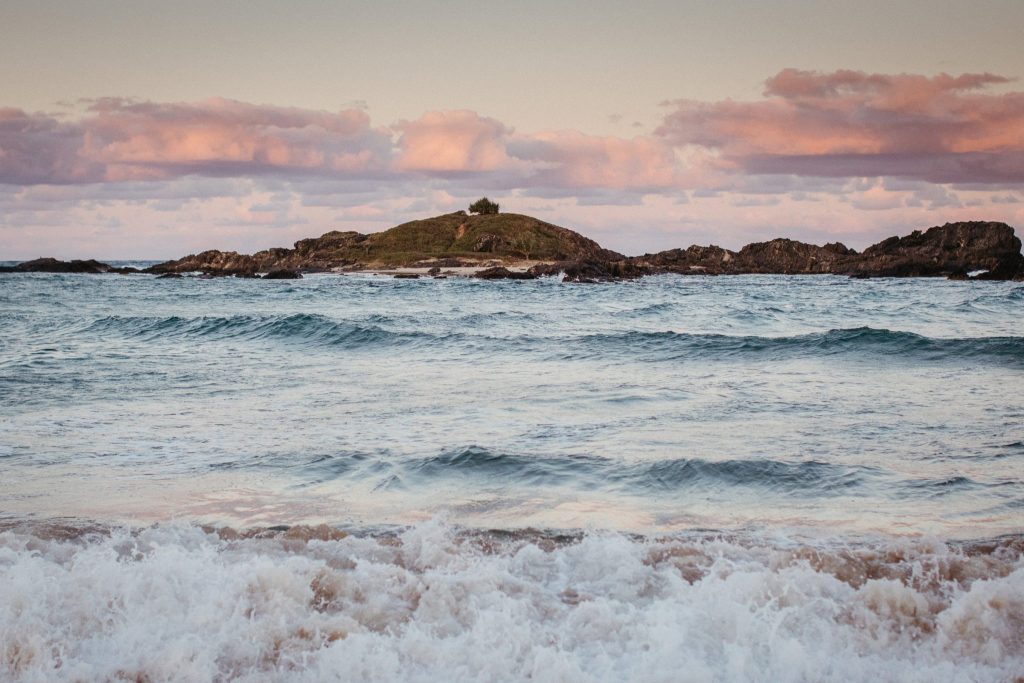Point of Change
Small coastal towns are moving in a new direction. But where are things heading? COVID-19 inspired mass-migration and development have prompted fear and uncertainty. Mid North Coast writer Bibi Ahmed explores the shift and considers her response: Push back and protect or release and accept?
New people are moving into town.
Change is on its way and there’s no escape. My sleepy, backwater home is becoming a destination for city sea-changers and once dirt-cheap houses are getting snapped up for magnified sums, before they even hit the real estate listings.
Casuarina Point * is moving in a new direction. One of the last places on the Mid North Coast untouched by development, we have long had a low-income population of pensioners, families, traditional custodians, floaters, grey nomads and full-time caravan park residents. This place is a coastal anomaly. For the 27 years I have lived around here, not a lot has changed. But now I feel a shift in the air. People from the cities are flooding in.

I was born in a city. Yet from an early age I felt out of touch with the urban landscape. At eight years old I ran away from home to live in “the country“. A place of grass and trees and creeks and horses and kookaburras and well, fairies and moss-covered rocks upon which to lay my head. My twin predilections for nature and “other“ realms left me disconnected to the city, yearning always for the open spaces, the fresh air and palpable magic of natural environments.
Leaving the city in my youth, I lived in a couple of other coastal bush havens before moving permanently to a beachside wonderland, just a short bike ride south of my current home in Casuarina Point. After marrying, raising a family and subsequently divorcing, the only place I could afford to buy a house was in town, where in 2012, prices were dead cheap. It took me six months to get used to living in town – the cars and street lights constantly alarming me – yet I eventually adjusted, to a degree, comforted by my proximity to the ocean and the total quietness of this small village.
How do I describe this place? I sit on my porch of a morning and watch old, life-battered men, in blue King G singlets and tiny Stubbies shuffle past; VB cans in hand and faded blue tattoos mottling arms. And I say to myself “this is the old Australian character that features in those Australian films – the ones Bryan Brown plays so well– yet are some kind of anachronism in modern, multicultural, gender-fluid Australia. This whole village is an anachronism, with its A-frame fibro cottages, abandoned holiday homes and Thursday night meat raffle at the Workers and Recreation club. Forever avoiding crowds, I revel in this place that lags behind time and is forgotten by progress.
I love my sleepy, coastal, backwater town, long derided by rich cousins, ignored by local government and home to fishos, families, First Nations locals and retirees. Our town is flat. Built on sand. A river separates the dwellings from the open beach of unpatrolled and often dangerous waters, frequented mostly by amateur fishermen and locals walking dogs. The lack of car access to the beach and the virtual absence of suitable surfing banks there have always provided refuge from the hordes of tourists and transmigrants from the Central Coast and northern beaches of Sydney who descend upon villages to our north and south. Our caravan park mostly hosts generational returnees, following their parents and grandparents’ footsteps to permanently booked holiday sites. This place, bordered by river, sea, mountain and bush, can be easily traversed on bicycle. With our simple but complete shops, you can can survive car-less in Casuarina Point fairly well. And so this place has long been a haven for low-income earners to survive on a shoestring in a quiet, low-key village surrounded by natural beauty.
But things are changing. In the face of COVID-19 inspired mass-migration out of cities, people with money are snapping up Casuarina Point homes like piñata lollies. And the renters don’t stand a chance. When houses are sold, renters must leave. It’s an unassailable algorithm. Where can they go? It’s already near impossible to get rental accommodation here. What happens when all the houses are sold?

And what about our First Nations locals? Such a strong and vibrant presence in our town. With deep connection to country and culture, they continue to practise age-old traditions and values, passing down knowledge to new generations and generously sharing wisdom and inspiration with non-Aboriginal locals. For me, meeting and engaging with these beautiful families has been the biggest gift of living here. Yet members of First Nations families who have lived here for generations are also finding it near impossible to find rental accomodation. My brain can’t assimilate this. Something is wrong.
And have I mentioned the other threat of development looming? Rumours have circulated for years about a vast tract of paperbark swamp on the north-west corner of town to be turned into a massive housing development once our sewerage goes in. I have heard it said that local government councillors, including the mayor have bought up land around Casuarina Point to maximise their share of profits from development. Is this true? Does anyone else in town share my concerns? Or do they just want development, development, development? To bring jobs, amenities and shiny bright consumption opportunities?
So here I sit. I gulp in concern at the SOLD SOLD SOLD signs on the Real Estate window. I quietly panic inside at the thought of an oncoming development onslaught. I judge the “rich city people buying up our town”. Why can’t they leave us alone in our anachronistic enclave?
And then I meet some newcomers. The foreigners. The invaders.
Oh.
They are nice. They share my values. They want to grow and swap plants and produce; create things with their hands; live a sustainable life. In the face of the real characters peopling my invasion story I cannot maintain my parochialism. I realise something. I like them.
Is this what it’s like for racists? Disliking an entire race of people, yet unable to maintain enmity once they engage on a one-to-one basis with a member of the despised group? Is my story of capitalist-driven development swallowing small towns colouring my view of the opportunities to come? Is it actually just families and individuals moving here rather than ominous city investors? Have I got it all wrong? Am I just some manky old person so stuck in a time warp that I can’t accept change?

And I realise something else. No matter how concerned I am about the changes seemingly about to engulf our town, I don’t have it in me to lead the anti-development movement.
It’s blindingly clear. I have to let go of control.
The impulse to protect my sheltered lifestyle is still there but not the energy to spearhead a movement against encroaching development. And so here it is. I will have to receive the newcomers with open arms. Recognise them as people opting for a change. For a simpler, quieter life, where their children can grow up kissed by sun and sky and bathed in fresh air and water. If I let go of control and flow with what is happening, something else entirely might transpire. I can’t stop development. But I can keep sharing plants and produce with my neighbours; support efforts to recognise and celebrate First Nations culture and history; promote community self-sufficiency, a culture of sharing; and recognise the humanity in every person I interact with. This I can do.
And so now my challenge is to let go. To succumb to the endless flow of life. To move from raging against the machine to acceptance. And open myself to the new energies flowing in. And who knows – like the newcomers to our town, they may not be as bad as I think.
Though I must say: I’d still rather live in a backwater…
*Casuarina Point is a pseudonym for a real town on the NSW mid north coast.




